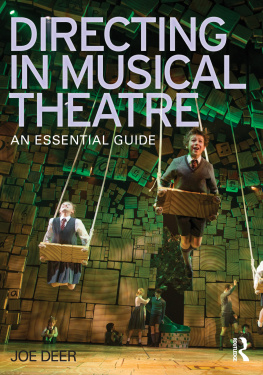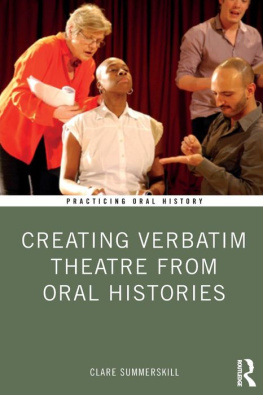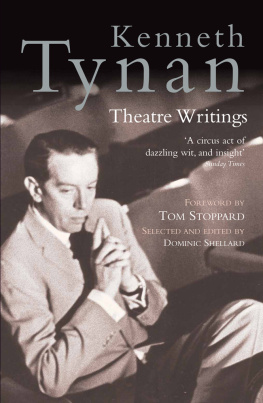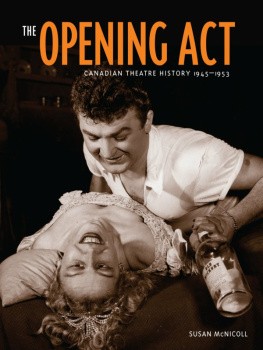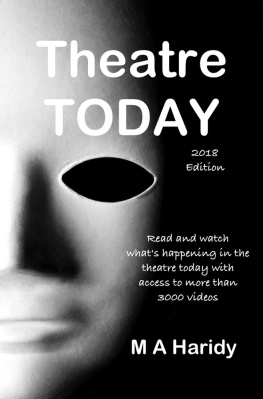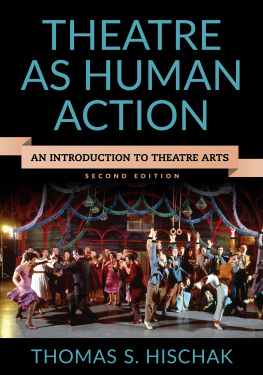A PRACTICAL GUIDE TO WORKING IN THEATRE
GILL FOREMAN

Contents
This book is dedicated to the memory of my grandmother Eleanor
Every evening, in theatres across the world, as the lights begin to dim and the chatter falls away to silence, somewhere in the darkness a quiet voice murmurs into a headset: House lights out. Act One beginners, please For the audience, thus begins two hours or so spent in an alternative reality the universe of a play, summoned up from wood and fabric made to look like glass and stone, peopled by actors pretending to be someone else, and orchestrated by dozens of unseen helpers whom the audience rarely notice because when we go to the theatre, how many of us truly understand the range of people and skills that have combined to make our evenings entertainment?
Most of us will encounter the box-office staff who sell us our tickets, ushers, bar staff and programme sellers, but what about everyone else who made our evening possible?
Theatre is a unique combination of crafts. Weeks before a play opens an extraordinarily dedicated group of people work long hours on low salaries to spin magic from ordinary stuff cheap wine glasses from a local discount store will be painted and painstakingly gilded to resemble the finest medieval Venetian crystal; fabric from a bargain bin will be dyed, starched and treated to become a beautiful and luxurious costume. Lights will be hung, angled and coloured so that you will believe its a bright midsummers day in the middle of December and carpenters will create entire worlds of concrete and steel out of plywood and polystyrene. Each department is working towards that opening night, that fixed moment in time when everything combines together in front of a live audience. Its unlike anything else in entertainment, and for those involved produces an energy that cant be replicated in the recorded arts of film and television.
A Guide to Working in Theatre explores and explains the work of each theatrical department. Each chapter attempts to get inside the production process from that departments point of view and includes interviews with those actually doing the work.
Finally, this book is dedicated to all of those creative but invisible stage people you wont necessarily meet them, but they do what they do because its their passion and because they want you to have an amazing evening. Live theatre is an exciting, challenging and sometimes difficult medium and it needs enthusiastic, well-trained and skilled practitioners to ensure its future. I hope you will decide to be one of them.
CHAPTER 1
An introduction to the theatre industry
Drama the desire to perform or enact a story is as old as the human race itself: for as long as people have gathered together they have told stories, of themselves, of the things that surround them, and of the issues that preoccupy their community. Rituals and ceremonies have evolved until at some point, rather than tell the story, the community, or members of the community decide to act it out. This pattern can be traced in almost every civilisation that has existed on Earth. However, a communal love of story and play-acting is not the same thing as a professional theatre, where those who take part earn their living.
Professional theatre in England was the invention of Elizabeth I and her government, and its first stars were Christopher Marlowe and William Shakespeare. I suspect, though, that even they would be amazed to see how it has developed!
In this chapter well explore the professional theatre landscape and seek to understand the structure of the industry as well as the process of a production.
The professional theatre industry today is extremely diverse and embraces everything from small independent theatre companies to large corporate entertainment conglomerates. There are commercial producers and small, locally funded community arts centres. There are large, national state theatre companies, regional venues and international companies, as well as tiny one-person outfits making street performance. They are all wildly different so how are we to make sense of it all?
The two industry sectors
Professional theatre can be roughly divided in two sectors, the commercial and the subsidised. Modern subsidised theatre is chiefly funded by central and local government, while commercial theatre receives no state or grant funding, operating in the same way as any commercial business, its money coming from the profits of previous productions and funds from investors.
Commercial theatre
At the heart of any commercial theatre company will be a producer or team of producers. They will have established a knack for finding hit shows and they will have a loyal group of financial backers or investors, known in the industry as angels. These angels will invest money in a production for a percentage of the shows profits, once it has paid for its costs. The commercial sector is unlikely to stage the work of a new or unknown playwright, or cast unknown actors in lead parts. Instead, lead roles will be played by well-known actors, often from film or television.
Commercial theatre companies rarely own their own venues they lease a theatre from one of the commercial theatre landlords for a fixed term, usually between six weeks and three months initially, with an option to extend the term if the show is a success. Some of the West Ends most successful productions have been running for decades the longest-running production being Agatha Christies The Mousetrap, which opened at the New Ambassadors Theatre in 1952 and is still running today, in its fifty-seventh year, at the St Martins Theatre.
Subsidised theatre
A subsidised theatre is one that makes no profit, and operates using funds donated by a patron. In the UK, subsidised theatre involves a whole sector of companies and their chief patron is the British government. The Treasury, via the Arts Council, distributes a series of grants that fund arts organisations, including theatre companies, in one of two ways. A key list of theatres receive annual capital grants to fund their day-to-day operations as well as the productions that they stage. In addition, the Arts Council also issues project grants, ranging from a few hundred pounds to multiple thousands of pounds, to theatre companies in order that they stage a specific production or project. There are also regional Arts Councils that do the same for regional theatre companies. Some companies also receive funding from their local county, district or town councils.
Subsidised theatre companies must spend government money properly and report regularly on how they do so. They cannot make a profit and they must keep ticket costs at a level that make them accessible to all. In addition to this, the conditions of the grant given include being a resource for their local community as well as carrying out education and participation programmes.
Types of theatre organisation
Within the broad division of the commercial and subsidised sectors there are further subdivisions as to the type and structure of the organisation. These structures are not exclusive to one or other sector, but exist in both.
Receiving houses
Receiving houses are theatres that produce no original work of their own. Instead, they host or tour in other peoples productions, usually those of commercial production companies. Much of Londons West End is made up of commercial receiving houses. Many of these are owned by entertainment conglomerates and, more recently, commercial producers who see the value of owning theatres in which they can stage their work, rather than paying rent to a theatre landlord. A receiving theatre is run by a very small management team who will hire in additional staff to suit the production coming in.


